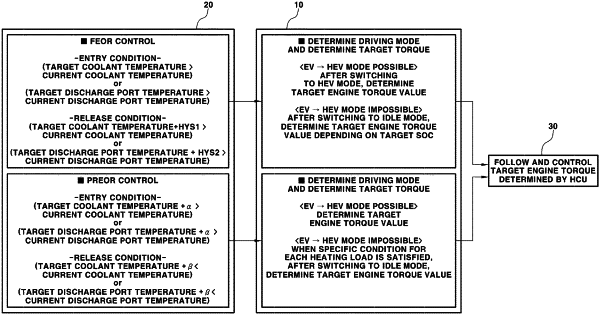| CPC B60H 1/00764 (2013.01) [B60W 20/20 (2013.01); B60K 6/24 (2013.01); B60W 2540/215 (2020.02); B60W 2710/065 (2013.01); B60W 2710/0688 (2013.01); B60W 2710/30 (2013.01); B60Y 2200/92 (2013.01); B60Y 2300/182 (2013.01)] | 14 Claims |

|
1. A method of controlling heating of a hybrid electric vehicle (HEV), the method comprising:
receiving a heating request from a driver;
when the heating request is received from the driver, determining whether an entry condition of full automatic temperature control (FATC) engine ON request (FEOR) control is satisfied;
when the entry condition of the FEOR control is not satisfied, determining whether an entry condition of pre-FATC engine ON request (PFEOR) control is satisfied;
when the entry condition of the PFEOR control is determined to be satisfied, checking whether the vehicle is capable of entering a HEV mode;
when checking that the vehicle is not capable of entering the HEV mode, determining whether the vehicle enters an idle mode for the PFEOR control;
when determining that the vehicle enters the idle mode for the PFEOR control, issuing a command for a target engine torque value and a target revolutions per minute (RPM) for the idle mode to an engine control unit (ECU) from a hybrid control unit (HCU); and
performing an engine idle speed control along with engine ON based on the command,
when the target coolant temperature+α is greater than the current coolant temperature or the target discharge port temperature+α is greater than the current discharge port temperature, determining that the entry condition of the PFEOR control is satisfied.
|